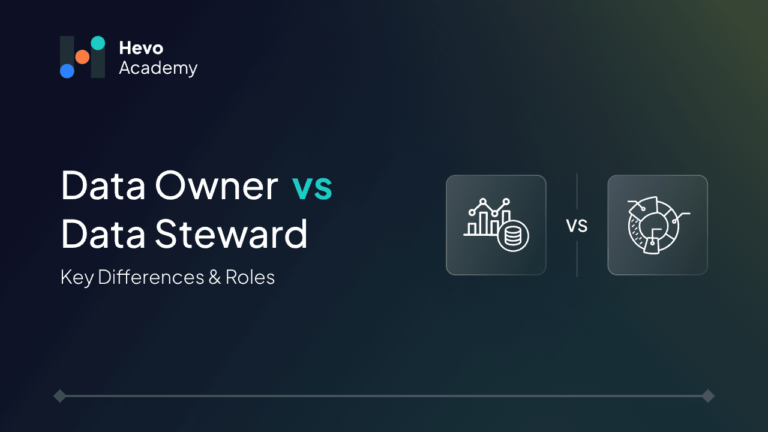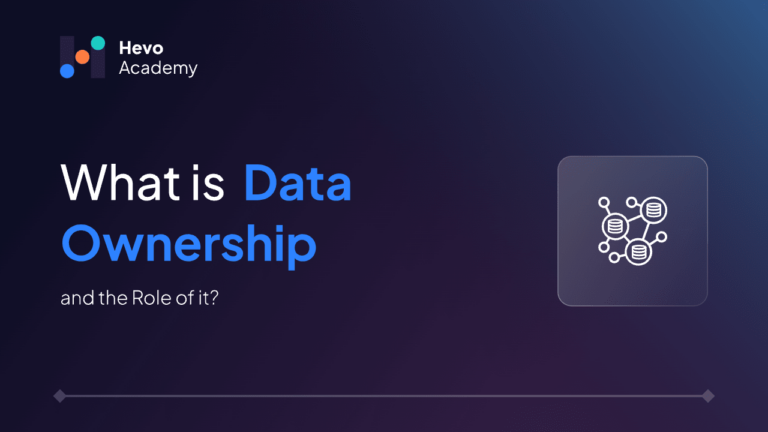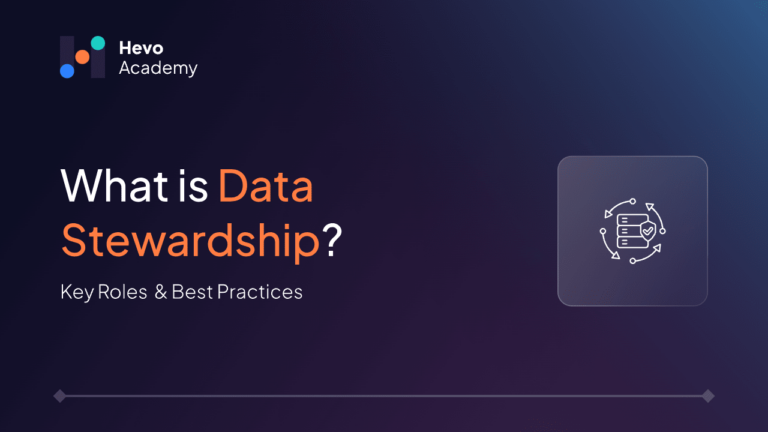In today’s data-driven world, maintaining data management is the most crucial part. Here comes the role of the Data Owner vs Data Steward who play a significant part in managing overall data security, integrity, and proper use of data across the organization. The data managed by the Data Owner and Data Steward is used to drive strategic decisions and also to achieve business goals.
Table of Contents
A Data Owner is a department or a senior-level person who is responsible for a specific set of data generated across the organization. The Data Owner is in-charge of setting data access rights such as who can access the data and how it can be used.
On the other hand, a data steward handles day-to-day data and plays an operational role. They are responsible for maintaining data quality, data accuracy and implementing data standards. Data Stewards, work closely with data owners to make sure whether the data is organized, and properly documented. In this blog, we will explore the roles of Data Owners vs. Data Stewards, highlighting their relationship and responsibilities.
Who is a Data Owner?
A Data Owner is a senior-level person in an organization who holds ultimate responsibility as well as legal rights for specific datasets. They ensure that the accuracy of the data used inside the organization is reliable. On the basis of security considerations, they set the boundaries such as who can modify, use, or share the data based on business requirements. They also include security measures involving setting up security protocols, encryption methods, authorization verification, firewalls to maintain data integrity. Data Owners work closely with Data Stewards or custodians who allocate and support data assets. Some key responsibilities include:
● Governing, protecting and approving data assets.
● Supervising data quality and decision-making.
● Collaborating with other Data Owners to overcome critical issues.
● Data usage and prioritization.
Who is a Data Steward?
A Data Steward acts as a data guardian or a custodian of data, ensuring that data is aligned with organizational standards. Data Steward also ensures that data is handled, stored, and used effectively. Data Steward understands the importance of the information and they are also considered as a Subject Matter Expert in their department. Unlike the Data Owner, who only focuses on strategic decisions, the Data Steward is responsible for data accuracy, consistency and accessibility throughout its lifecycle.
DS works closely with other teams such as IT departments, and Data Owners (DO) to maintain data governance practices for handling data, which includes practices such as data cleansing, data validation, and normalization procedures. Some key responsibilities include:
● For each use case ensuring that the data is available and accurate.
● Maintaining data quality objectives.
● Preventing data from errors, inconsistencies and data duplications.
● They are also involved in preparing well-documented data policies for easy data use across various departments within the organization.
Overall Data Steward acts as a caretaker of data, ensuring it remains reliable and consistent.
Data Owner vs Data Steward
In data management, Data Owner and Data Steward are essential where roles focus on ensuring that the data is managed well, but their responsibilities, scope, and focus areas differ slightly. In this section, we will distinguish these two key roles and highlight their unique contribution to data management.
Here’s a detailed comparison between Data Owner and Data Steward across various aspects.
| Aspect | Data Owner | Data Steward |
| Role | Overall responsibility of data governance and strategy | Data Steward manages data quality and accessibility. |
| Responsibility | Ensures data aligns with business objectives and legal compliance, and also makes sure the data is secure. | Responsible for data quality, accuracy and well-maintained documentation for operational use. |
| Scope | Focused on data policies, security and compliance across organizations. | Focused on specific data sets, handling data maintenance, data validation, and usability. |
| Collaboration | Work with senior-level individuals and other key stakeholders to align data with business goals. | To ensure data usability and data consistency, DS collaborates with IT and business users. |
| Accountability | Accountable for overall data governance and strategic decisions. | Accountable for data integrity, data quality and handling of data properly. |
| Authority | Data Owners have the authority to define data policies and data access levels. | Data Stewards have authority over operational aspects such as managing data and ensuring data-related policies. |
| Decision Making | Making high-level data decisions on data policies and data access. | Applying decisions made by Data Owners. |
| Expertise | Requires strategic knowledge of data compliance, data governance and business needs. | Requires operational expertise in handling data standards, metadata management and data quality management. |
In summary, Data Owners focus on strategic oversight, compliance and making high-level decisions, the Data Steward plays a hands-on role in managing data quality and maintenance.
Relationship between Data Owner and Data Steward
The relationship between Data Owner and Data Steward is a collaborative work, where both roles work together to ensure effective data management and usability of data within the organization. Let’s discuss the relationship between these two roles and how they complement each other.
1. Strategy and Governance Alignment – The Data Owner is responsible for setting strategic and overall governance of the organization’s data. On the other hand, Data Steward takes high-level policies and puts them into action on a daily basis. The steward follows the rules set by the Data Owners.
2. Compliance and Risk Management – While the Data Owner ensures the organization’s data standards, the Data steward plays a role in maintaining data quality to meet compliance requirements. Stewards are hands-on in ensuring data consistency, and data accuracy, thus mitigating risks related to data breaches or non-compliance.
3. Feedback – Continuous feedback involves in-between the Data Owner and Data Steward ensuring data practices remain aligned. Data Owners are given data insights, which helps them to refine data governance policies.
4. Access Rights – How and who can access the data within the organizational rules are set by the Data Owner. However, the Data Steward handles the operational side of things. They also make sure that the data is kept up-to-date, correctly entered, and available to authorized users. According to the Data Owner’s guidelines, the steward manages the data in day-to-day activities.
5. Governance Framework – In a data framework, both are complementary:
Data Owners – Provide vision and strategy.
Data Stewards – Handle day-to-day operational activities.
Together, they play a pivotal role in ensuring that data is not only secure and compliant but also a valuable resource for the organization’s success. Their partnership is essential for maintaining the integrity and reliability of data across the enterprise.
Key Responsibilities
The roles of Data Owner and Data Steward are both important in data governance, but their focus, scope and execution differ. The below section gives a detailed comparison of the key responsibilities.
1. Data Owner: Key Responsibilities
a. Strategic Decision-Making:
● Data Ownership: They define how data aligns with business goals, and determine how it should be used within the organization.
● Business Alignment: Data Owners ensure that the data align in a way where it supports business objectives.
● Access Control: Data Owners determine who can access data.
b. Governance and Policy Development:
● Data Classification: It influences how data is handled throughout its lifecycle.
● Policy setting: Data Owners are responsible for ensuring legal compliance and regulatory standards.
c. Compliance Management:
● Industry Regulations: Data Owners oversee industry compliance e.g., General Data Protection Regulation (GDPR), Health Insurance Portability and Accountability Act (HIPAA), and other data protection laws to protect sensitive information.
● Data Risk Management: DO ensures data is well protected from unauthorized access or misuse.
2. Data Steward: Key Responsibilities
a. Data Quality and Data Integrity:
● Data Stewards are tasked with identifying missing values, duplicates, or any inconsistencies. By continuously monitoring data quality, it helps in making strategic decisions.
● Data Stewards cleanse and validate data, ensuring it meets business standards, rules, and as well as organizational requirements.
b. Metadata and Documentation:
● Data needs to be well-documented, so that it can be used across organizations effectively. Data Stewards play a major role in managing and documenting data.
● Metadata is an important context for understanding of data, Data Stewards organize and document metadata, enabling users to find and interpret data correctly.
c. Data Collaboration and Integration:
● Data Steward ensures that data from various departments, or systems are integrated smoothly to keep up-to-date and it can be accessed across organizations.
● Data Stewards regularly gather data needs from the business users to better understand their requirements. They also assist in helping users access the data they require for their utilization and decision-making.
Examples to Understand Differences Between Data Owner and Data Steward
The roles of Data Owner and Data Steward are often misunderstood when it comes to data governance. To help clarify the distinctions between the two, let’s look at a few practical examples.
Example: Managing Customer Data
● Data Steward: The Data Steward makes sure the customer data collected is accurate, clean, and formatted properly. For example, they are responsible for checking duplicate records in the customer database and customer information such as address, phone number, and emails.
● Data Owner: In this case, the Data Owner could be a CMO Chief Marketing Officer, where he would be responsible for defining objectives for customer data. They ensure that the data being used complies with privacy laws like GDPR etc.
Example: Product Data in E-commerce
● Data Steward: The product information such as product description, pricing, images, are kept up-to-date across the e-commerce platform and are maintained by the Data Steward. For example, if a new batch of products is added to the inventory, the Data Steward ensures the data entered into the system are free from errors and consistent across different channels as well such as the website, mobile app, and in-store.
● Data Owner: For an e-commerce company, the Data Owner might be the Chief Product Officer who is responsible for establishing policies for product data.
Conclusion
In data management, the roles of Data Owner and Data Steward are crucial for maintaining the security, accuracy, and effective use of data within an organization. While their responsibilities overlap in some areas, they each have distinct roles that contribute to an organization’s data governance framework.
The Data Owner holds strategic oversight, making key decisions about data policies, access controls, and compliance with legal standards. They focus on how data aligns with business goals and set the framework for data security and risk management.
On the other hand, the Data Steward plays an operational role, ensuring the day-to-day management of data. Data Stewards work closely with business users to understand their needs and ensure the smooth integration and usability of data across systems.
Together, these two roles form a dynamic partnership, ensuring data remains reliable, secure, and effectively utilized for the organization’s success.
Connect with us now to transform your data integration experience and maximize the potential of your data!
FAQs
1. What is the role of a data owner?
● A Data Owner is responsible for the overall management and strategic direction of specific data within an organization.
● They set data access policies, ensure compliance with legal and regulatory standards, and align data with business objectives.
● Data Owners also make critical decisions regarding data security, risk management, and ensure data is used effectively to support organizational goals.
2. What is the role of a data steward?
● A Data Steward is responsible for managing data quality, ensuring accuracy, consistency, and accessibility across systems.
● They maintain data standards, cleanse and validate data, and collaborate with teams to ensure proper data documentation, making it reliable for operational use.
3. What is another title for data steward?
● Data custodian
● Data guardian
● Information curator
● Data overseer
● Information steward
● Data manager
All reflecting the responsibility for maintaining and organizing data effectively across systems.
4. What tools do Data Stewards use?
Data Stewards use a variety of tools to maintain data quality and integrity. These include data management platforms like Informatica or Talend, data cleansing tools such as Data Ladder, metadata management software like Alation or Collibra, and business intelligence tools like Tableau or Power BI for data analysis and reporting.




